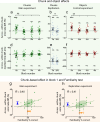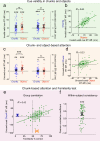Statistically defined visual chunks engage object-based attention
- PMID: 33431837
- PMCID: PMC7801661
- DOI: 10.1038/s41467-020-20589-z
Statistically defined visual chunks engage object-based attention
Abstract
Although objects are the fundamental units of our representation interpreting the environment around us, it is still not clear how we handle and organize the incoming sensory information to form object representations. By utilizing previously well-documented advantages of within-object over across-object information processing, here we test whether learning involuntarily consistent visual statistical properties of stimuli that are free of any traditional segmentation cues might be sufficient to create object-like behavioral effects. Using a visual statistical learning paradigm and measuring efficiency of 3-AFC search and object-based attention, we find that statistically defined and implicitly learned visual chunks bias observers' behavior in subsequent search tasks the same way as objects defined by visual boundaries do. These results suggest that learning consistent statistical contingencies based on the sensory input contributes to the emergence of object representations.
Conflict of interest statement
The authors declare no competing interests.
Figures




References
-
- Spelke ES. Principles of object perception. Cogn. Sci. 1990;14:29–56. doi: 10.1207/s15516709cog1401_3. - DOI
-
- Marr, D. Vision: A Computational Investigation Into the Human Representation and Processing of Visual Information (W. H. Freeman and Company, San Francisco, 1982).
-
- Peterson MA. Object recognition processes can and do operate before figure–ground organization. Curr. Direct. Psychol. Sci. 1994;3:105–111. doi: 10.1111/1467-8721.ep10770552. - DOI
Publication types
MeSH terms
LinkOut - more resources
Full Text Sources
Other Literature Sources
Medical

